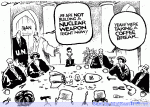
In a recent speech at the American Enterprise Institute, U.S. Ambassador to the United Nations (UN) Nikki Haley sought to dismantle the political and intellectual firewall that has, for over a decade, thwarted the development of a comprehensive U.S. policy toward Iran.
Haley rejected the prevailing notion that Iran’s nuclear activities comprise a special sort of threat that can be addressed in isolation from Tehran’s overall malign behavior. Regrettably, reactions to Haley address failed to reckon with this point because they narrowly focus on her assessment of whether Iran is in compliance with the 2015 nuclear deal. Yet this reaction perfectly demonstrates the importance of Haley’s main argument about the need to broaden our view of the threat from Iran.
Since the Iranian nuclear dossier was referred to the UN Security Council (UNSC) by the International Atomic Energy Agency (IAEA) in 2006, the nuclear issue quickly became the sole gauge of the U.S.-Iran relationship.
Under the Obama administration, this dynamic led to a prioritization of nuclear diplomacy to such a level that it impeded fruitful discussion of how to deal with the broader Iranian threat package. The controversy surrounding the 2015 nuclear deal, formally known as the Joint Comprehensive Plan of Action (JCPOA), made this problem even more acute. Although the accord was supposed to resolve the nuclear issue and thereby broaden the discussion, the opposite happened.
For that reason, Haley’s comment that “The deal drew an artificial line between the Iranian regime’s nuclear development and the rest of its lawless behavior” should imbue Iran watchers with cautious optimism that the U.S. has removed its nuclear blinders.For too long, Iran’s nuclear program was treated as if a creative cocktail of sanctions relief and limited fissile material controls could dampen the material and ideational forces that have sustained it — and which also drive its foreign and domestic aggression. Worse, it also led to the false assumption that whatever challenges Iran could still pose to American interests would be marginal by comparison on the backend of a deal.
This narrow and tiered approach did not permit Washington to generate leverage on the nuclear file in non-nuclear theaters of competition. Rather, it subordinated its own regional policies at the altar of attaining and maintaining an accord whose reach was limited by design. And on the select occasions when policymakers did infer linkage between Iran’s regional and nuclear policies, Washington balked at opportunities that would have provided it with an improved negotiating position.
One such opportunity was the fabled 2013 “red line” crisis in Syria. Another in that very same theater was President Obama’s 2014 letter to Iranian Supreme Leader Khamenei. In it, the president reportedly indicated that American air power would not be aimed at Iran’s long-time partner in Damascus — President Bashar al-Assad and his Ba’athist regime.
But single-minded pursuit of a nuclear accord with Iran predates the Syrian conflict. A desire to avoid any action that might reduce the prospects for a nuclear deal also influenced the Obama administration to steer clear of any meaningful support of protests in Iran during the summer of 2009, now known as the “Green Movement.” This is both sad and ironic, because no population has suffered more “lawless behavior” by Iranian authorities than its own citizens, who have endured countless human rights violations over the years.
Another indicator of the manmade division between the nuclear and non-nuclear challenges posed by the Islamic Republic pertains to the alleged violations of an annex of UNSC Resolution (UNSCR) 2231 which Haley mentioned at length.
UNSCR 2231 both codifies the JCPOA and enshrines a set of companion agreements that address non-nuclear threats. Annex B of UNSCR 2231 contains clauses that bar arms transfers, ballistic missile testing, and deployments of entities abroad that should be subject to an asset freeze and travel ban. Haley’s underscoring of Iran’s habitual transgressions of the non-nuclear prohibitions in this annex — which are semiannuallydocumented in reports by the UN Secretary General — could serve as the basis for pressure in the UNSC to develop a new resolution or to commence multilateral negotiations on Iran’s ballistic missiles — which European leaders appear increasingly willing to consider.
As I have co-written with the executive director of a Washington-based arms control organization, a major weakness of UNSCR 2231 is that it establishes no investigative bodies or enforcement mechanism for non-nuclear violations. If these violations are to be addressed in a fashion that keeps the trans-Atlantic alliance unified, the U.S. must leverage data from UN reporting to develop a new consensus in international fora that Tehran’s non-nuclear misbehavior matters just as much as its nuclear mendacity.
By dispensing with the firewall that has previously separated discussions about Iran policy into the categories of “non-proliferation” and “everything else,” Haley has enabled a more honest discussion about what a comprehensive Iran policy could or should look like.
As the Trump administration continues its lengthy inter-agency review of the Iran deal and on Iran policy more generally, Haley’s comments may afford American policymakers more opportunities to creatively muster diplomatic, informational, military, and economic assets against Tehran — irrespective of the turbulent politics surrounding the future of the nuclear deal.
Behnam Ben Taleblu is a senior Iran analyst at the Foundation for Defense of Democracies, a nonprofit research institute focusing on national security and foreign policy. Follow FDD on Twitter @FDD.
View Original Article: http://thehill.com/blogs/pundits-blog/foreign-policy/349819-nikki-haleys-iran-speech-shows-blinders-may-finally-be-off










